Affiliate disclosure: This post may contain affiliate links. Please see our Privacy Policy.
Beech nuts are tasty, nutrient-dense nuts produced in the fall by beech trees (Fagus sp.). The nut husks are incredibly distinctive, and it’s hard not to stop and pick up the brightly colored velcro covered husks for a closer look.
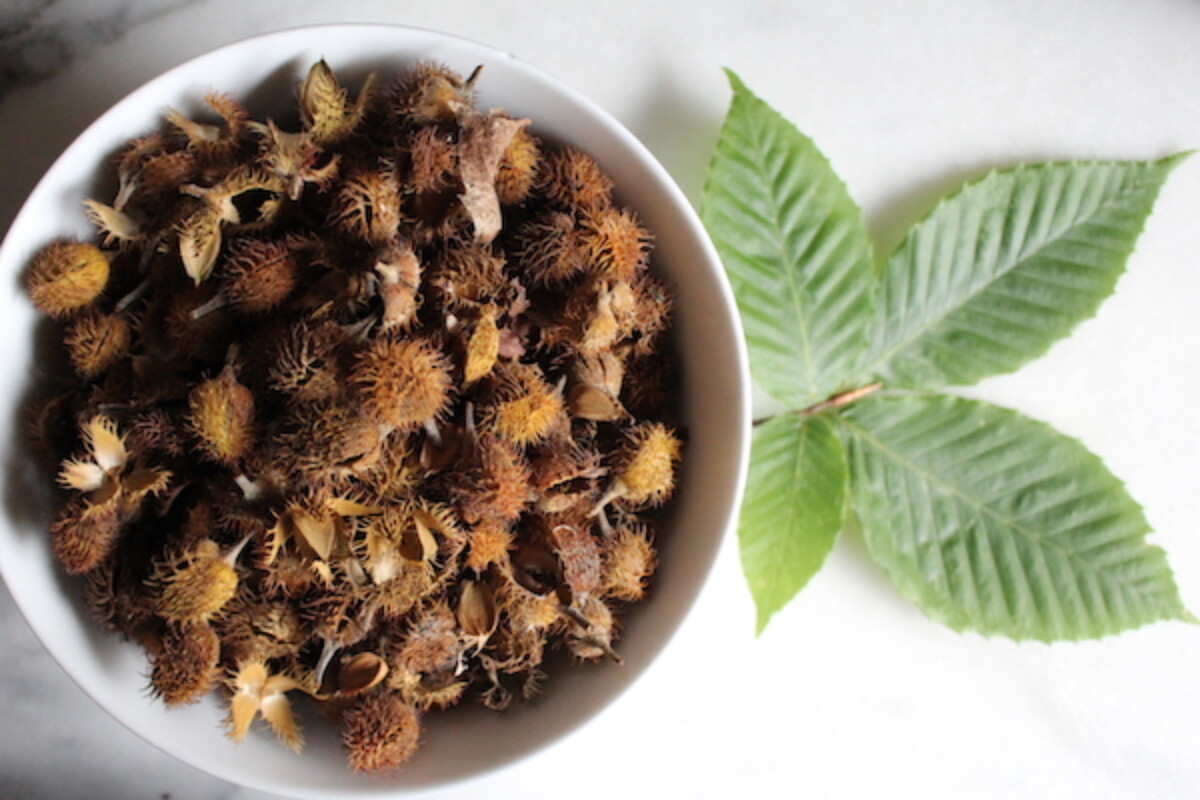
Walking in the woods a few years ago I came across a tiny, brightly colored spiky pod mixed in with the leaves. I bent down to investigate and found that the forest floor was covered with them, all around a particular tree with grey smooth bark.
A little research and I learned that I’d found beechnuts. Historically, they were a popular food source in both Europe and America, but these days hardly anyone’s ever heard of them. That’s largely because they’re difficult to harvest mechanically, and they are not nearly as large as the nuts that grace our modern tables.
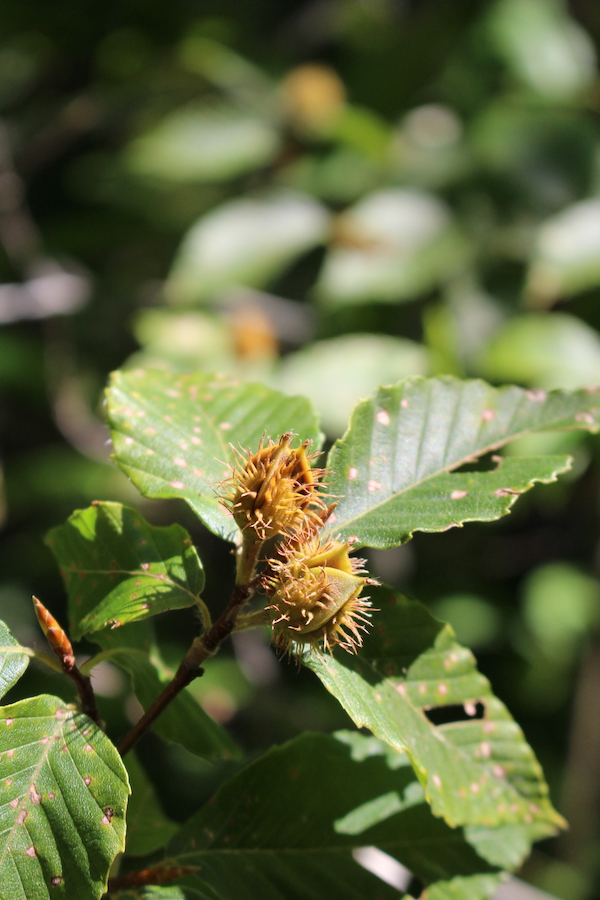
For foragers, beechnuts a fall goldmine of healthy calories. With roughly 50% fat and 20% protein, beechnuts can help balance out a foragers diet that this time of year is heavy with apples and other sugary carb-laden fruits. To compare, acorns are only about 7% protein.
Beechnuts have a spiky exterior husk that pops open when ripe, revealing two small nuts, each oddly shaped with 3 pointed sides. Inside the outer husk, the seeds have a fibrous inner shell, that you can easily remove with a fingernail (once the nuts are dried and cured).
They ripen and fall in late September in Vermont, and if you wait until mid-October like I did this year they’re mostly hidden under leaf litter and much harder to find. Still, rake back the leaves under a beech tree and you’ll spot the distinctive pods.
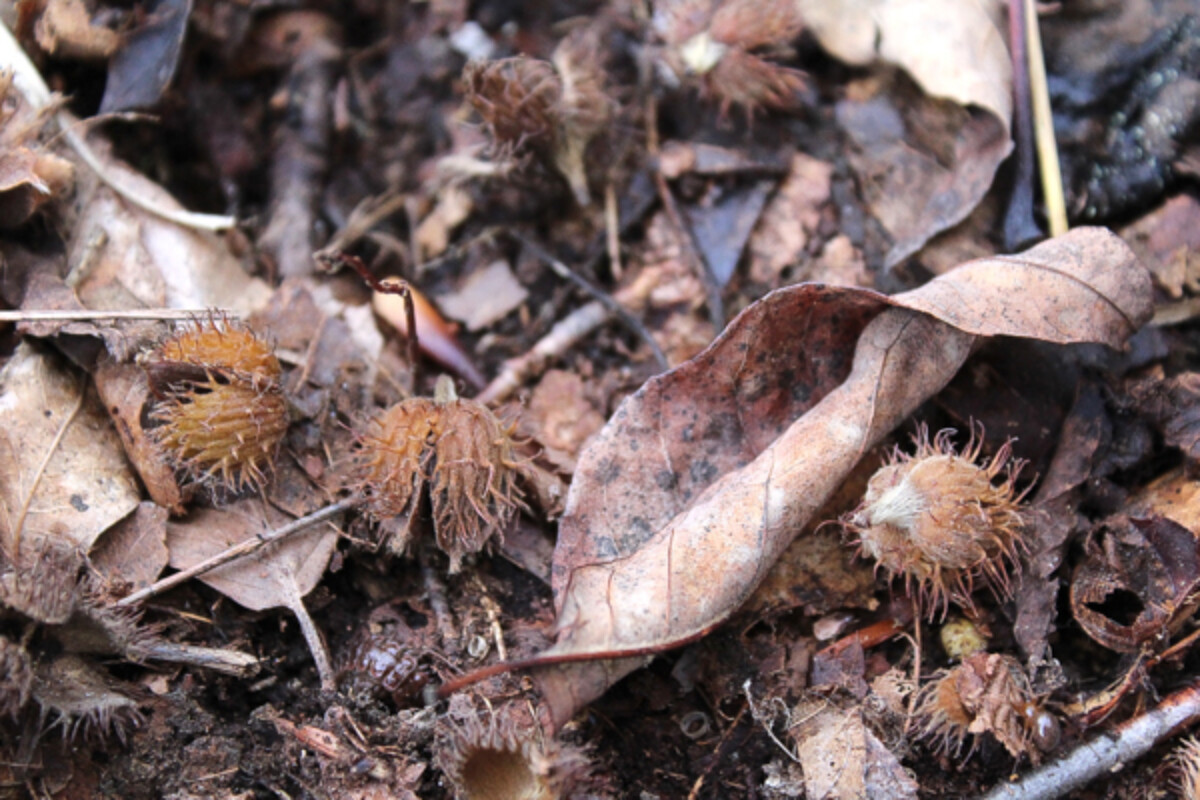
The nuts themselves have a slight tannin taste, but that didn’t stop my 2-year-old from gobbling up as many as she could find. While food bloggers have to fight to keep their kid’s hands off the cookies while they’re taking photos, this mama blogger has to watch out for tiny hands sneaking in to steal beechnuts.
Sneaking a few raw beechnuts is fine, but for the most part, they need to be cooked before eating them. Raw they contain the toxin saponin glycoside, which can cause gastric issues if you eat a large number of raw beechnuts.
Some Native American tribes have long eaten them raw without ill effect, so their toxicity level is a bit subjective by the individual. Roasting improves their flavor and destroys the toxin at the same time.
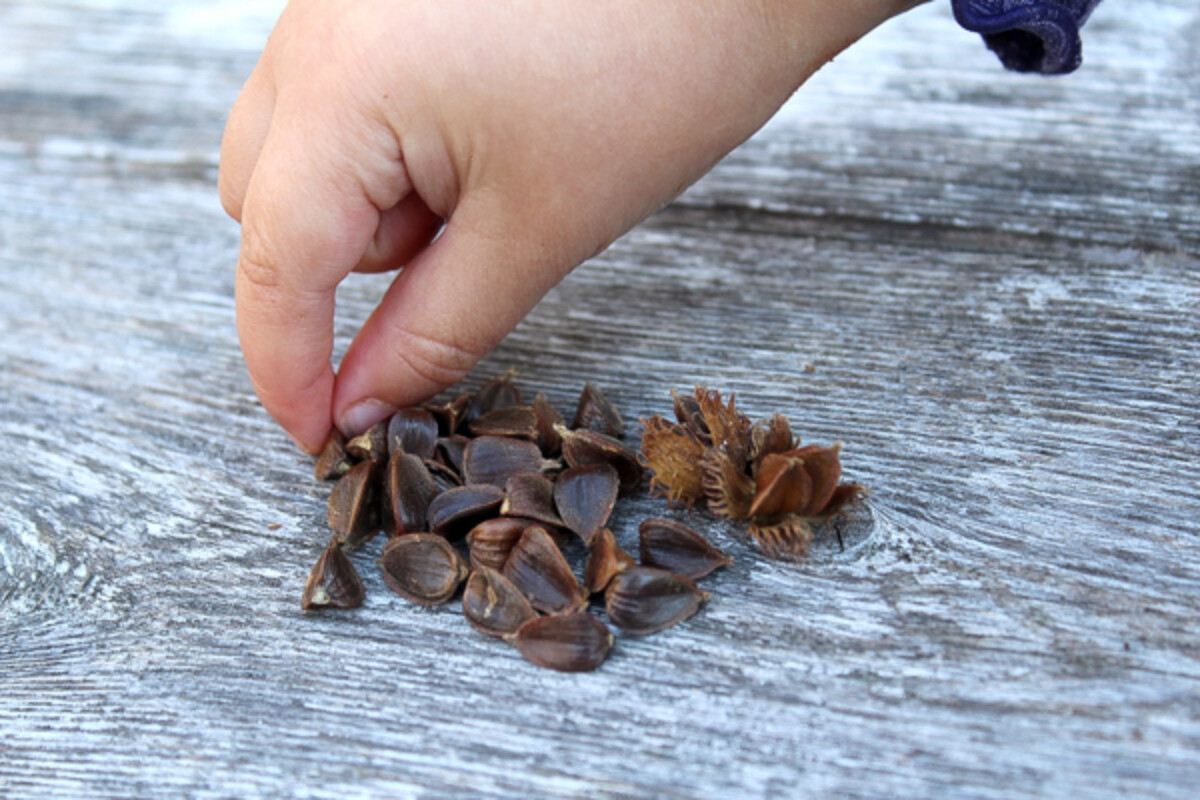
Identifying Beech Trees
To identify a beech tree, look for a tree with smooth grey bark. Follow the trunk up to find ovate leaves with points along the sides, about 2 to 6 inches long. The leaves are shiny green in the summer, and turn copper-colored in the fall.
They have distinct pairs of veins coming off a central vein, each ending in a tiny point at the leaf edge.
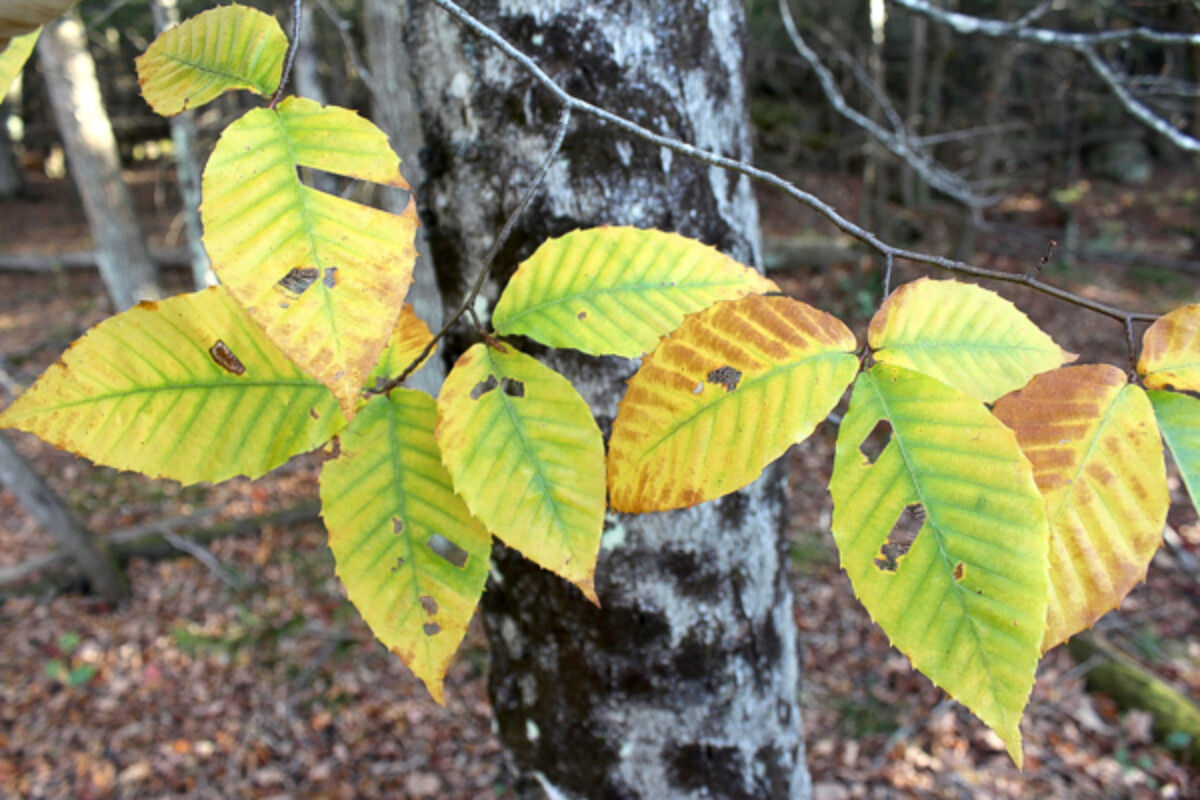
The bark sometimes has scales or fissures because of beech scale disease, and diseased trees will produce substantially fewer nuts. Beech scale disease will also cause the tree to produce nuts with empty seed shells. You’ll pull off the velcro outer casing, and then remove the inner shell with your fingernails, only to find that the seed is empty.
Beech scale disease is actually two different pests that form a positive feedback loop. A tiny scale insect, called Cryptococcus fagisuga wounds the bark, and then those wounds are colonized by two different types of fungus, Neonectria ditissima and Neonectria faginata. It’s the fungus that eventually kills the tree. The problem is, once the cycle is started it’s hard to reverse.
The fungus makes larger wounds in the bark, which allows more insects to colonize, which in turn allows more openings for the fungus.
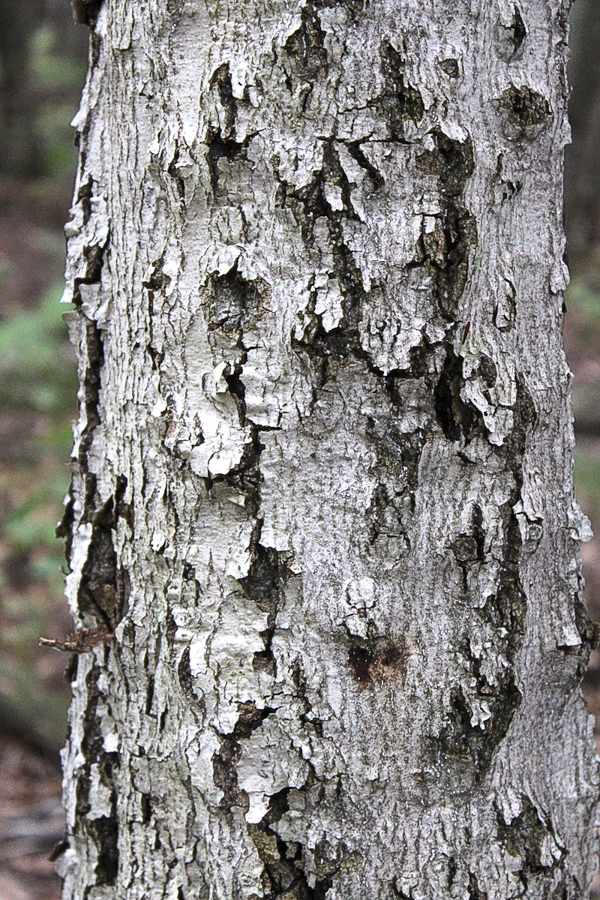
Unlike other tree species, which are going extinct as a result of their non-native diseases and pests, the beech is still going strong. It’s killed back from the top, but generally recovers and suckers up from the bottom. The downside, however, is that as this disease progresses, the trees produce more and more empty beech nutshells. That’s less for the birds, deer and human foragers to find on any given woodlot.
If you’re curious about the specifics of the scale insect and associated fungus, this article from Northern Woodlands is a good summary. For the best beechnuts, look for the smooth grey trunk of a healthy beech tree.
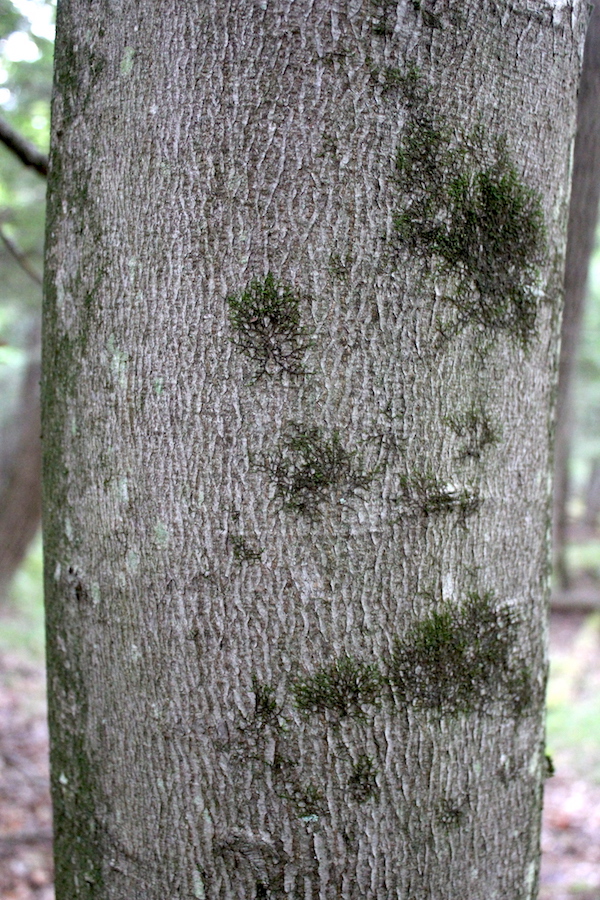
Processing Beech Nuts
Processing the pods is pretty straightforward. The nuts can be husked by hand quickly and easily by rubbing bunches of them between towels and then picking out the husks. The husks do have spikes, but unlike chestnut husks, they’re not particularly sharp. More like velcro than spikes.
After the outer husks are removed, allow the nuts to dry for about 2-3 weeks. Like most nuts, the interior nut meat is pretty wet right off the tree and the flavor improves with a bit of patience. Simply remove the outer velcro husk and then lay the nuts out in a single layer in a well ventilated indoor space for a few weeks.
Once cured, beechnuts will keep for years provided the interior shell is fully intact. Unless you plan to use the nuts right away, store the nuts in their shells after curing. A jar rodent-proof jar with a tight-fitting lid works best.
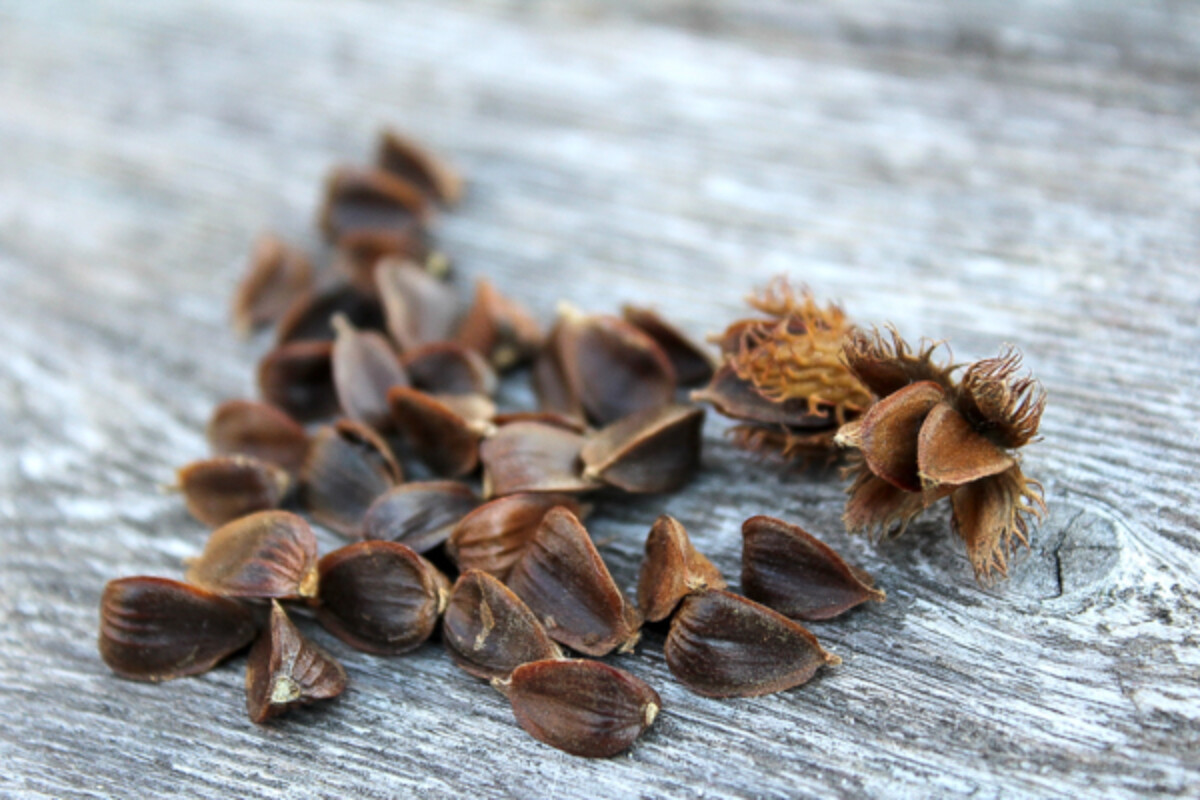
If you do plan to use the beechnuts immediately, the next step is to remove the inner leathery shell. This, I’ll admit, is time-consuming if you’re harvesting beechnuts in quantity. The shell is thin, and you can easily peel it apart with your fingernails or quickly crack it between your teeth before pulling it apart.
It’s about as difficult to remove as sunflower seed shells. That is to say, not hard to accomplish but requires patience.
Inside each triangular shell, you’ll find a single beechnut.
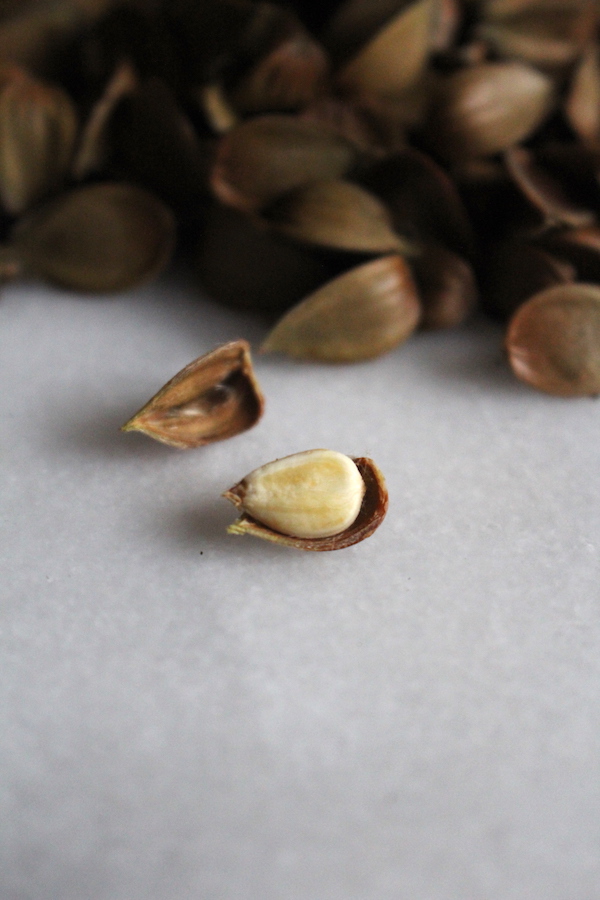
I’ve read that some beechnuts are brown when they come out of the husk, and they’re coated by yet another papery husk. This papery husk has tiny hairs that can cause throat irritation and should be removed. Simply rub the shelled nuts between two towels and then pick out the white nuts.
That said, I’ve yet to run across it? I’ve mostly seen it in association with the European beechnut species (Fagus sylvatica) and I’m foraging American Beech (Fagus grandifolia).
After that, beechnuts are roasted in a pan about 3-5 minutes until fragrant. The cooking neutralizes any toxins present in the nuts, and gives them a wonderful flavor.
Culling Beechnuts
When you forage beechnuts in the woods, much of your harvest will actually be empty shells. Part of this is due to the beechnut diseases that cause the trees to produce blanks, and a part of it is due to insect pests.
Often, you can tell if a beechnut shell is a “blank” before you even open it. The shell itself will be a bit concave or collapsed in on itself because there’s no nut inside.
Similarly, if an insect has beaten you to the beechnut, there will be a tiny exit hole where they left after consuming the nutmeat.
If you see either of these two issues, save yourself a lot of time shelling beechnuts by discarding these before the curing step.
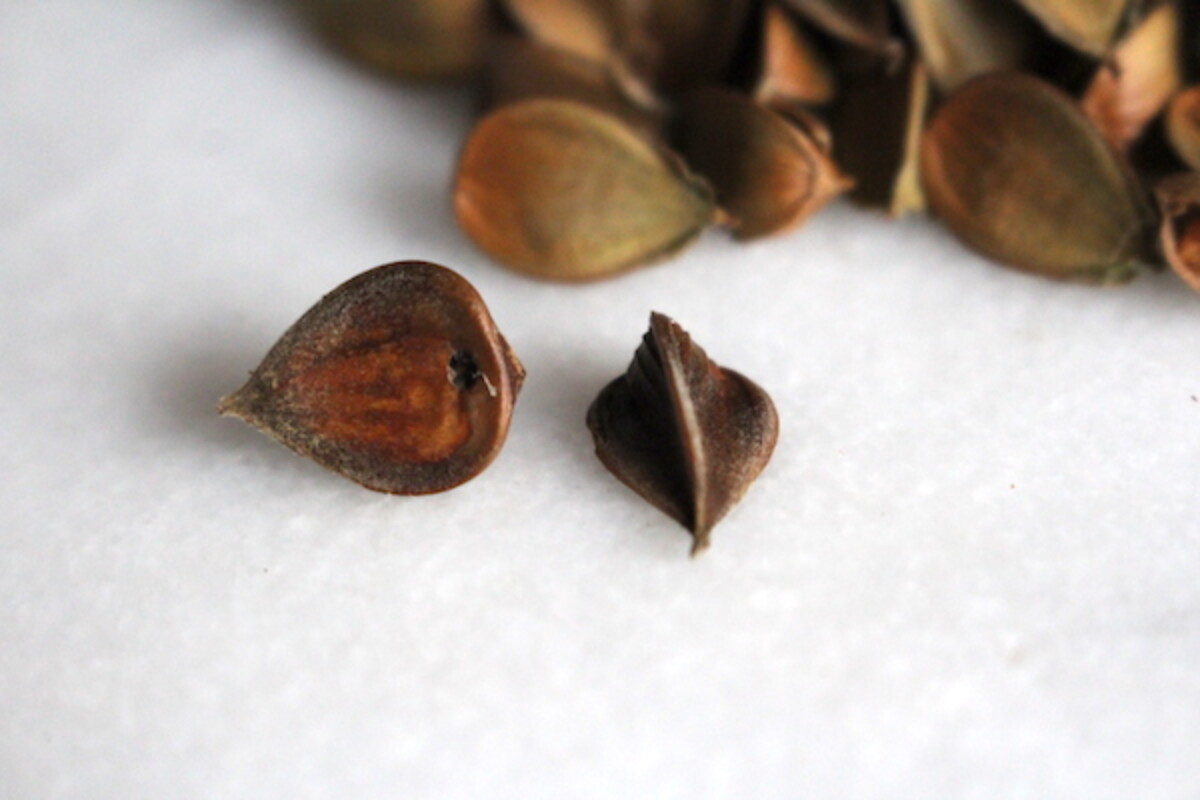
Historical References to Beechnuts
In Farmer Boy, one of the Little House on the Prairie books, Almonzo goes off into the woods with a wagon to gather beechnuts, and then they’re processed through the same thresher that the family uses for oats, beans and grains:
“’What say we run some beechnuts through?’ Father asked. So they pitched beech leaves into the hopper, and now the whirring fans blew away the leaves, and the three-cornered brown nuts poured out. Almanzo filled a peck-measure with them, to eat that evening by the heater.”
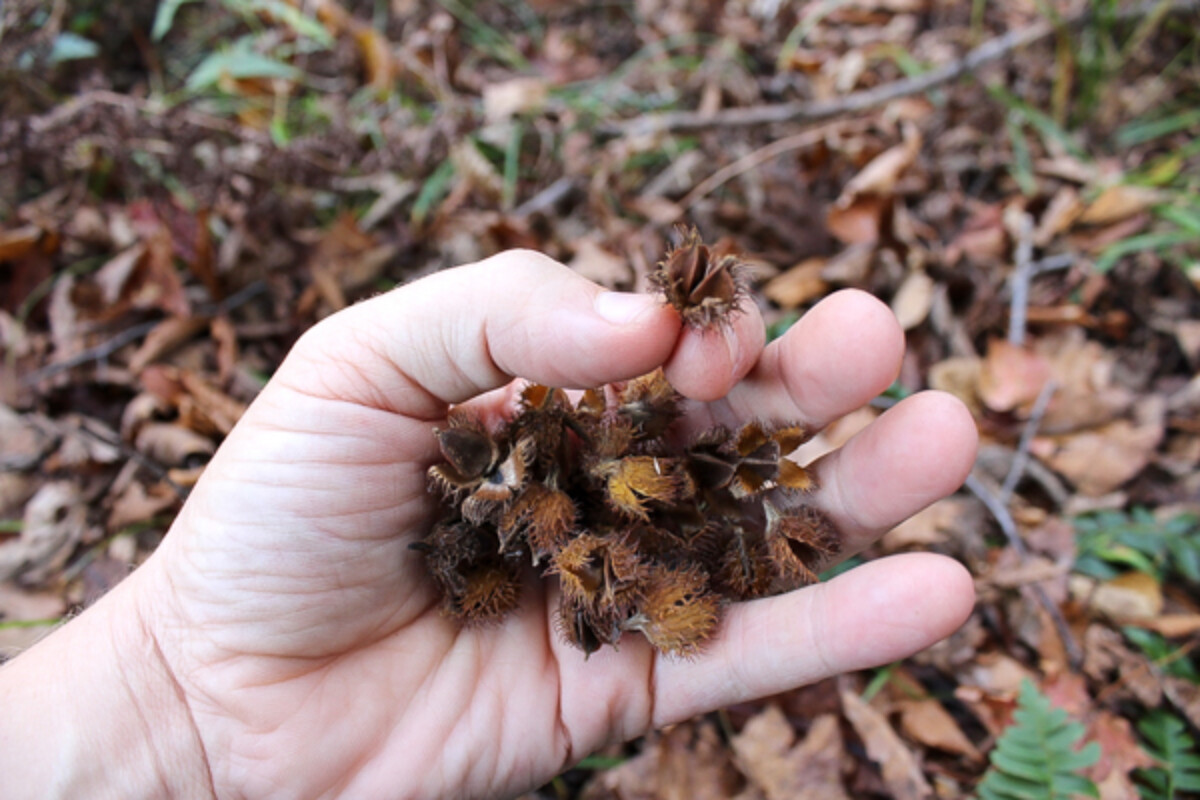
Cooking with Beechnuts
Though in the US beechnuts are mostly considered a foragers novelty or a survival food these days, in Europe beechnuts are still used for cooking. The french press out the rich oil for flavorful salad dressings at a rate of about 1 quart of oil to 10 pounds of nuts.
They also roast and grind the nuts into a coffee substitute, that according to some is one of the best you can forage. Personally, I’m partial to dandelion root coffee, and I’d rather save my beechnuts for fresh eating.
Historically in the US, beechnuts were ground into flour and cooked into cakes. Settlers extended the life of their flour by replacing half of it with beech flour in cakes, and at the same time got a more flavorful and nutritious cake as a result.
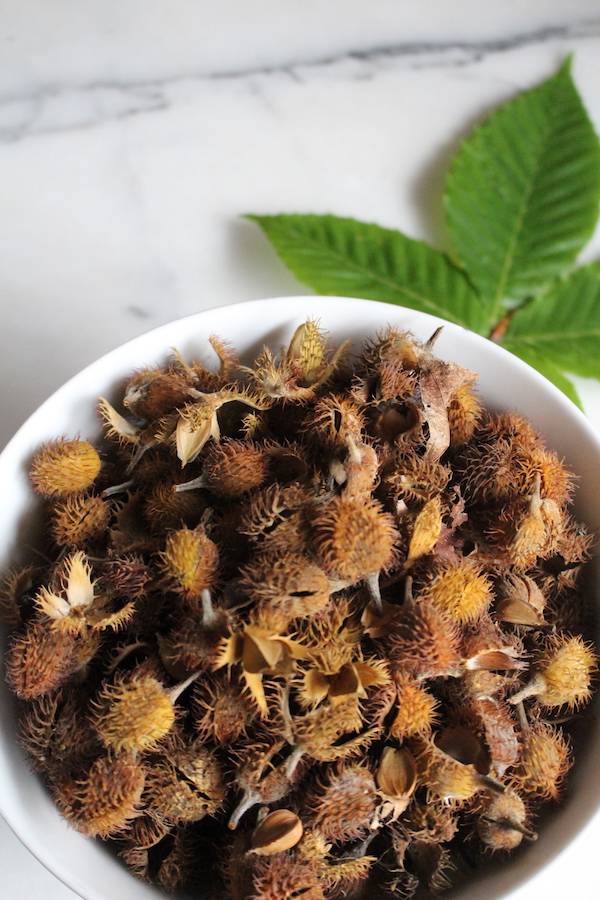
Recipes for Cooking with Beechnuts
Here’s a tutorial on how to make Beechnut Butter.
I’ve also found a couple more substantial recipes for beechnut baked goods, and I’ll keep looking for more historical sources and post them here as I discover them.
Beechnut Muffins Recipe
Adapted from Edible Wild Plants of Pennsylvania and Neighboring States
This recipe makes a savory muffin that’s more like a rich buttery dinner roll than what we think of today as a sugary muffin. Note that there’s no added sugar.
1 Cup Beechnut Flour
1 Cup Cornmeal
1 Cup Flour
3 tsp. Baking Powder
1/2 tsp. Salt
2 eggs, beaten
1 1/2 Cups Milk
2 tsp. Butter, melted
1/2 Cup Beechnuts, chopped
Mix dry ingredients in one bowl, and beat wet ingredients together in a separate bowl. Add the wet ingredients into the dry ingredients, and then add in the chopped beechnuts. Pour into prepared muffin pans (greased or with muffin cups) and bake for 20 minutes at 375.
Oatmeal-Beechnut Pie Recipe
Adapted from Edible Wild Plants of Pennsylvania and Neighboring States
This recipe makes a pie that’s a bit like a traditional pecan pie, but it’s thick and chunky with oats and coconut along with your wild foraged chopped beechnuts.
1/2 Cup Beechnuts, finely chopped
3 Eggs
3/4 Cup Rolled Oats
1/2 Cup Butter, Melted
1/2 Cup Coconut, dried and shredded
1 Cup Maple Syrup
3/4 Cup Cane Sugar (do not use beet sugar, the pie will not set)
1 pie crust in a 9-inch pan (unbaked)
Beat the eggs, and combine all ingredients in a bowl. Pour into a pie shell and bake at 350 for 45 minutes.
Other Beech Products
Beech trees can be tapped for syrup, just like maple trees. We’ve tapped many different species of tree, including birch trees and ironwood trees, but I haven’t experimented with beech.
Tapping trees involves injuring the bark though, and I’ve been reluctant to try because I didn’t want to a site of potential infection. That said, I recently learned that my efforts would have been in vain in any case…tapping beech trees requires a vacuum pump system, and that means it’s only viable for commercial operations.
A local syrup operation just down the road started producing beech syrup on a commercial scale, and they were kind enough to answer some of my questions about the process. According to Michael Farrel at New Leaf Tree Syrups,
“Beech only runs sap with high vacuum and the yields per tap are very low, in fact, we only produced .03 gallons of syrup/tap last year, which is one of the reasons it is so much more expensive than maple. We’re still figuring out the exact timing for beech syrup, but the ground needs to be thawed for the roots to be able to draw in moisture through vacuum pump. I think in our area (central Vermont) we should tap beech mid-March after the maple has had a few decent runs.”
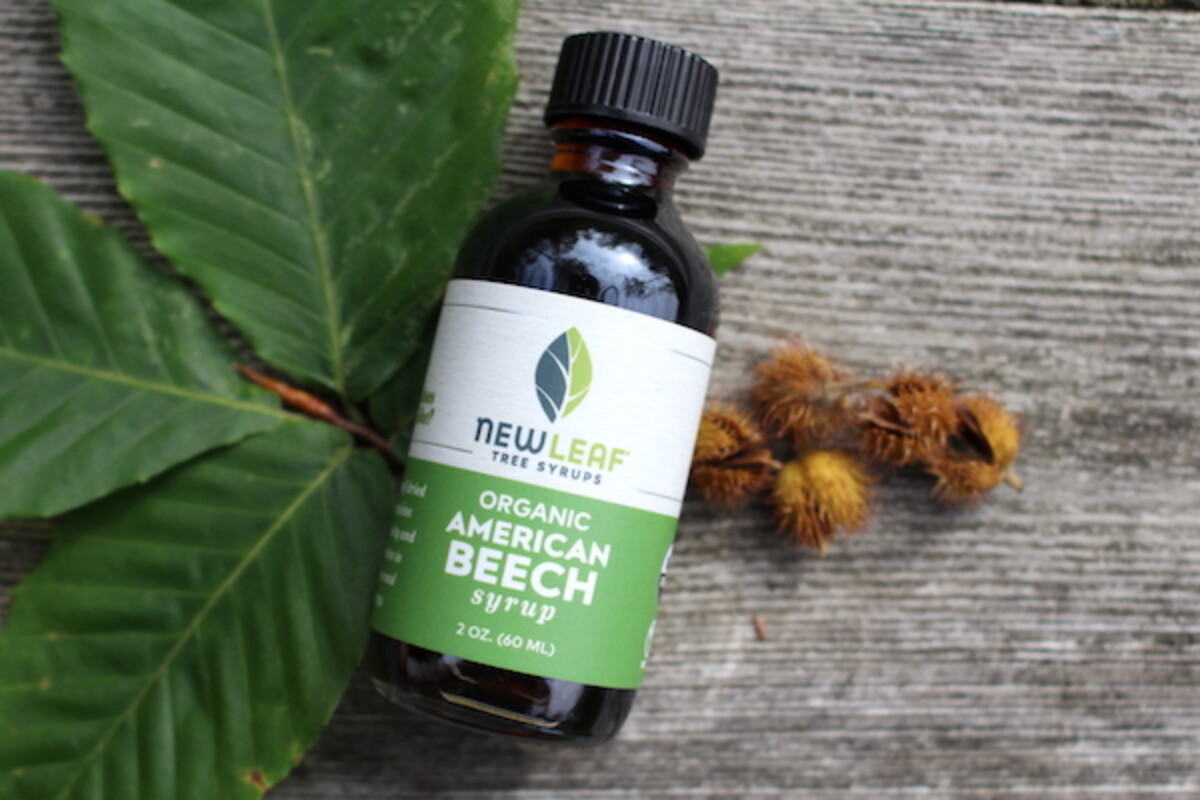
Even if homemade beech syrup isn’t really realistic for our small maple tapping operation, I was pretty excited to pick up this tiny bottle of beech syrup. My kids absolutely loved it, and finding yet another way to eat a beech tree got them even more excited about helping me forage for beechnuts.
It only seems proper that I use this beech syrup to make them a tiny, tasty beech centered reward. My plan? I’m going to modify this maple pecan pie recipe and make an all beech pie. I’ll substitute beech syrup for the maple, and beechnuts for the pecans obviously. I’m even planning on making a simple beechnut crust instead of the traditional pastry crust.
After this year’s beechnuts cure, I’ll let you know how it goes. Until then, enjoy your time in the woods foraging beechnuts!
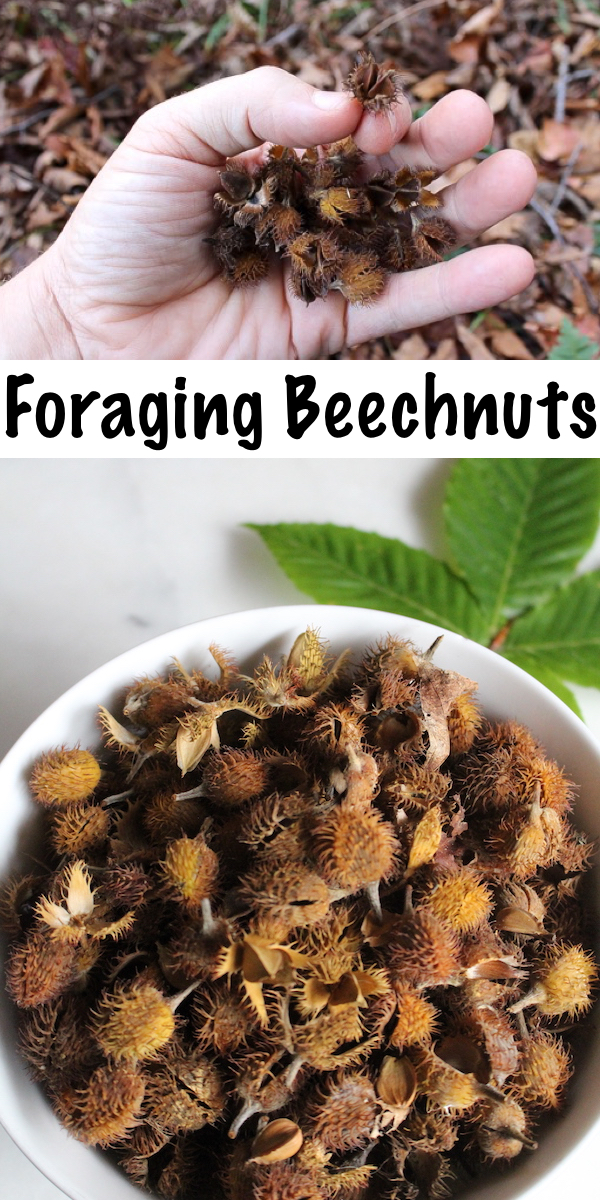














Fantastic! I love to hear about what you are doing and the wonderful experiences you are gifting to your kids!!!👏🙌
You can use them instead of pine nuts to make good pesto. Thanks for a really good article.
Great, thorough article! I am from north of Burlington, VT but have lived in NC for the past 35 yr. We have several beech on our property, which the grey squirrels enjoy. I’ll be foraging their leftovers now!
Wonderful!
So thankful I found your post about the Beech nuts. I was uncertain if they could be eaten. Some where in my memory I thought you could. My dad was always teaching me about trees growing up. Was hiking a new trail recently while camping and came across several enormous beech trees near a river that had dropped their nuts everywhere. Started my mind to wondering about their uses. Now I can’t wait to try some. Thanks for the recipes and encouragement to try them.
You’re very welcome. So glad you enjoyed the post. Let us know how you like the recipes.
for the recipes, are the nuts cured and roasted prior to using or just cured?
thanks
When consumed raw they contain the toxin saponin glycoside, which can cause gastric issues if you eat a large number of raw beechnuts. Roasting improves their flavor and destroys the toxin at the same time.
Great article, thanks. I’m in UK and was out for our weekly hike in a local park and came across some beech trees baring nuts, I have memories of eating foraged nuts as a child, in Windsor Park but couldn’t remember what they all were. I shall look forward to some foraging once they have ripened!
How wonderful to find some beech nuts. Enjoy them!
I went to a boarding school from the age of seven, back in the seventies. Beechnuts and sweet chestnuts scavenged from the local woods were an essential part of our diet. The head masters wife was set on starving us. “I don’t like fat boys” she would often be heard muttering. Her husband, the head master, was possibly the fattest person I have ever come across… I have fond memories of hoarding beech nuts in my tuckbox.
What an interesting story. Thank you so much for sharing.
We used to shell them and drop them in crisp packets in the school playgrounds and eat them raw with no ill effects. That said we were not eating very many at once because they were hard to peel. 70s kids were determined and resourceful, no?
This is a great article! We will harvest our beechnuts now 😋 greetings from slovenia
Hi Julia! So glad you enjoyed the article.
I have Beech trees. All over my property I love beechnuts. I’ve been eating Them since I was a child.
Sage, I am from
Louisiana and we use to find beef trees along the Calcisue river. I would pick them
Up by the pockets full. I haven’t seen a beech tree in probably 30’years. I now live in Oaklhoma and I Connor find a beech tree anywhere. Are you in the Northeast.
Hi can you harvest beech nuts if they are no longer inside the outer husk (the hard spiky shell?
Yup, they fall out easily and you can often find just the nuts on the ground.
Thanks for the great article, it is very informative. I’ve got a large Beech (fagus sylvatica) in my garden in the UK. Wood pigeons and squirrels love the nuts but I’ve never tried them myself, just thought they’d be inedible, but you have inspired me!
I must say the spikey seed cases make a real mess of my lawn though:(
Regards
John
So true, they do make a big mess. At least the spikey casings are relatively soft (on the US variety anyway). I’ve accidentally stepped on a spikey casing from a chestnut and those things are a different story altogether. Like big balls of needles!
I’m glad you’re going to try them, enjoy!
Hello,
Following from Denmark. Great post. 🙂 We are starting to find the pods on the ground but the nuts are currently green. If they collect them now will they ripen by themselves or should we leave them and wait for more mature pods to fall later in the year? Thank you. 🙂
Good question, and honestly I’m not sure! I’d assume they wont ripen to be as fatty if collected before they’re fully ripe (like fruit picked early never gets quite as sweet, even if it does ripen). I’ve never found them green, I always see them bright in the fall landscape when they pop open all prickly. I’d love to hear how it goes if you collect any green, because now I’m curious if they will ripen correctly. Let me know!
Thanks for this! As a child I lived on the family farm in an area known as Beechwoods, in western Pennsylvania. I remember my grandfather teaching me about them. I’ve foraged for chestnuts, hickory nuts, acorns & black walnuts, too.
I’m a country girl in the UK. I’ve always known about them and happily eat them raw by the handful and have yet to have ill effects. My mum makes a lovely brittle out of them.
I’ve moved to the city in the last 10yrs and came across one today on the school run. My 3yr old loved the fact she could eat one and we plan to go back later to get a bag full.
Great story, I haven’t had any ill effects from them either. I also eat elderberries raw, and they’re supposed to be toxic unless cooked too. I assume that maybe some people are more susceptible…
I remember eating myself sick of elderberries in my grandmother’s garden and was then expected to eat a Sunday dinner afterwards. I couldn’t
Have you tried them in a pesto? We have found a decent supply of beech nuts and I have tonnes of parsley growing – I was thinking of lunch tomorrow!
Nice! I bet they would be fabulous in pesto!
They remind me of pine nuts in appearance, so pesto kept running through my mind. Glad to hear that I was on the right track. Next year, I’ll have to go foraging for some!